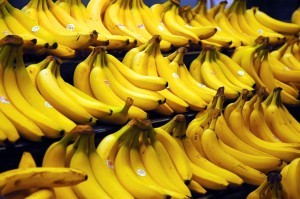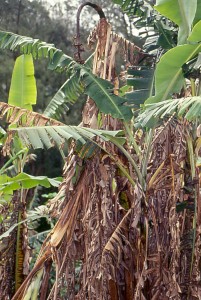The world’s most popular fruit, the banana, is at risk of dying out due to a fungus that is destroying crops in almost every country it’s grown in. The fungus causes the incurable Panama disease, which is currently killing off the popular species sold across North America and Europe known as the Cavendish banana. Scientists from Wageningen University have traced this fungus for decades, and their most recent findings show that it has spread dangerously fast across the globe.

The Cavendish Banana. Source: wikipedia
The fungus is known as Tropical Race 4 (TR4), and is the fourth type of fungus found capable of spreading the Panama disease. So far TR4 has been found in China, Indonesia, Malaysia, Australia, the Philippines, South Africa, and most recently in Jordan, Pakistan, and Lebanon. The fungus targets banana plants through the soil, where it can enter the plant’s roots and block off it’s water source until it wilts and ultimately dies. TR4 spreads by releasing spores, which can live in the soil for up to 30 years after the crops die off.
TR4 is especially dangerous because each spore is a clone of the very first TR4 fungus, meaning every spore has the exact same genetic material. This means every fungus is equally as powerful in killing banana plants, and there is no chance of any fungus having a mutation and being defective. Even worse, banana plants are extremely susceptible to this disease. You may have noticed that bananas don’t have seeds. The reason why is that the Cavendish Banana is sterile, and can only be reproduced from offshoots of adult plants or by growing cells in a nutrient bath. In turn, they are all genetically identical, meaning these bananas are also clones of each other. They are all equally vulnerable to the Panama disease, therefore it spreads very quickly through crops.

A banana plant killed by the Panama disease carried by TR4 fungus. Source: Wikimedia Commons
This isn’t the first time bananas have been threatened by the Panama disease. In the 1960s, it drove another type of banana, the Gros-Michel, into near-extinction. It was after this devastation that farmers started growing the Cavendish banana. It was originally thought that Cavendish bananas were resistant to the Panama disease, that is until a new strain of the Panama disease carried by the TR4 fungus was found to infect them.
The biggest exporters of bananas in the world, Central and South America, have not yet been hit with the Panama disease. However if we want to stop the bananas we know and love from going extinct, drastic strategy changes in the way we currently grow bananas will need to be made, including finding a new variety of banana that is immune to the deadly effects of the TR4 fungus. Time is running out, and it will take a global effort and commitment in order to stop the increasing spread of TR4 and save the banana.
The following video presented by SciShow gives a great summary of the Panama disease and the extinction of banana plants:

- Emma Peachey, March 6, 2016





